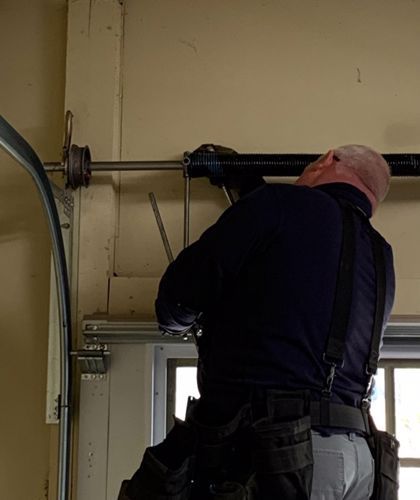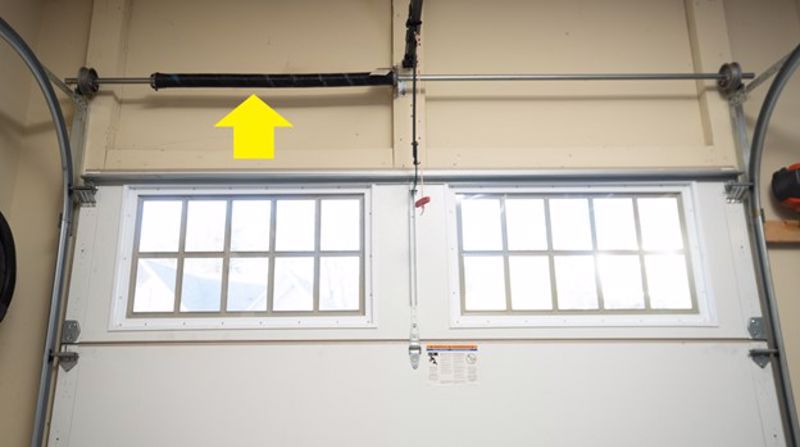Your Complete Guide to Garage Door Springs
- Feb 27, 2023
- Seasonal Tips
- 11 minute read

Springs are a major part of your garage door. They keep your garage together and play a significant role in its function. Unlike some other components, if your springs break, you’ll need to replace them. Proper replacement involves making sure you’re sourcing a spring that has the right amount of pull or the correct number of turns.
Let’s dive into this comprehensive guide to your garage door springs, outlining what to look for if you suspect they’re beginning to wear down.
Your garage door springs keep it buoyant. Find out what can happen when they break.
Know the Difference: Torsion vs Extension Springs
Before we dive in, it’s important to begin by understanding the difference between torsion and extension springs — the two types of springs you’ll encounter on your garage door. Since this technology is a bit outdated, you’ll likely find springs on your sectional door if you haven’t replaced it yet since moving into your home.
Torsion springs
To start, torsion springs always run above the garage door. They end in metal fixtures, known as cones and connect to metal tubes instead of pulleys.

Torsion springs run parallel to your garage door.
A torsion bar garage door fixture runs along metal shafts that connect to the cable drums in each corner of your garage. Most metal sectional doors have a single torsion spring, although heavy commercial or double garage doors will have two.
Torsion bars turn rather than extend and they have fewer parts and last longer than extension springs. They typically last 20,000 turns or seven years – double the life of extension springs. They have a lot more control over their motion than extension springs, too. The reason for this control quality is so that your garage door can remain balanced and aligned as it opens and closes.
Extension springs
Extension springs are an antiquated technology commonly found in older homes. They generally run along the sides of the sectional door.
Extension springs connect to pulleys that run along the walls of the garage and are connected to cables. They are designed with a single loop, double loop or clip system. They’re more prone to wear and tear and last around 10,000 cycles.
Installation can also be tricky, as they require a balance between springs and pulleys. They need to be connected to more parts than torsion springs. With more components involved in the installation, more things can go wrong if you were to put the system together yourself.
How much does it cost to replace garage door springs?
The cost of replacing your garage door springs varies depending on a few different factors.
The first is damage. If the spring has completely fallen to pieces and you need entirely new hardware, the price for the piece and labor could be as high as a couple of hundred dollars to just a few dollars. For older models or heavier residential garage doors, the door will require specific parts and a skilled professional who has experience in your particular setup.
For a minor break that may only need lubrication and a checkup, the cost lowers significantly.
Can I replace my springs myself?
Like many areas of your home, you may be tempted to just fix the spring yourself if you’ve noticed some abnormal behavior in your sectional door. While you may be able to repair it on your own, this is highly not recommended.
As we’ve mentioned, a spring repair on your garage door has a lot of moving parts like a pulley system, balancing and many other elements. Tension points could cause serious injury if not worked on by practiced hands.
Torsion springs, in particular, carry a lot of energy and you don’t want that strain to lash out in your direction. If you’re not 100% sure what to do, you should call a professional instead of changing them for the first time and following directions either on a manual or, worse, YouTube.
A professional is equipped to handle the risk of repairing torsion springs.
Even if you have extension springs, there’s still the issue of balancing the garage door and putting each piece in the right place. The result of not completing the right steps in the correct order could mean, in a best-case scenario, that the door is just not usable. In a worst-case scenario, without the proper setup, your sectional door could be dangerous to be around.
In the end, you may save a few bucks doing it yourself, but the cost of getting hurt and going to the hospital far outweighs any benefits of DIY.
Are garage door springs dangerous?
A garage door can open and close easily — manually or electronically — because of the tension within the springs that lighten the weight of the door. Springs carry hundreds of pounds of force. When the garage door lowers to the ground, gravity allows the door to fall while pushing on huge load-bearing springs that create necessary strain. This energy is held here until you need to open the garage door again.
Without the springs, the garage door weighs twice as much. When your door springs break, neither your garage door opener, nor your own strength can get it open. Plus you have other safety factors you must consider as well.
All of this is to say that yes, your garage door springs are dangerous to replace on your own because the tightly wound coils that cause the system to function are under an extreme amount of tension. One wrong move or unpracticed hands could result in serious damage to the door, your belongings and your body.
Are garage door springs covered by my home warranty?
A home warranty is a great way to protect your investment and even pay for some upgrades and repairs. But, you may not be fully aware of what exactly the guarantee covers. Generally, your home guarantee covers major appliances and your garage door falls under this category.
In most places around the U.S., a garage is an important part of ensuring your well-being by protecting your car and belongings from snow, ice, wind and rain (sometimes even giving you a space to work). If your garage door breaks, you may wonder if it’s covered by your insurance. Typically, your garage door tracks, springs and door aren’t covered unless something like a natural disaster occurs. In such an instance, you would instead tap into your homeowner’s insurance for coverage.
Funnily enough, though, your garage door opener is covered under your home warranty.
Can I adjust them myself?
Similar to replacing a broken garage door spring, adjusting a spring can be just as difficult and dangerous. Any time you’re interacting with any kind of garage door spring repair — whether that’s a broken spring or just a spring that needs a seemingly minor adjustment — it’s always recommended to work with a garage door expert. With hundreds of pounds of tension behind the springs, a minor mistake could mean life or death.
You’ll know it’s time to call in professional help if the following issues are present:
- A garage door may be too loose if your door struggles to open, but closes rapidly.
- If the spring system is too tight, the garage door may open too quickly, yet barely close all the way.
- When you close the garage door, you’ll know it needs to be balanced if one side doesn’t close all the way.
If any of those signs sound a lot like your own garage door, then you should call in a garage door professional to help you rectify these problems. If you put off a garage door repair, you may face dealing with one or both springs breaking which could cause more damage to your personal belongings and anyone nearby — and that could be more costly than just minor repairs.
Why Do Garage Door Springs Break?
Residential garage door springs are 10,000-cycle springs. A cycle is considered complete when the garage door has opened and closed once. With up to three or four uses a day, you should get at least seven years out of your springs with the right maintenance. However, garage door torsion springs may offer you up to 12 years because they don’t require as much maintenance or use as many other garage door components.
It’s inevitable that, over time, micro-fractures develop in the spring, which will eventually cause it to weaken and break. Weather also plays a role, temperature fluctuations of 20 to 30 degrees can cause it to wear out more quickly.
If you’re wondering whether your garage door is completely broken or just needs an adjustment, the difference will be obvious. When your garage door springs break, you’ll know – the door will be loud and won’t work at all. It’ll be difficult to manually lift it and no amount of new batteries for your garage door opener will do the trick.
Being able to tell if your spring has broken just by looking at it will depend on the type of spring your garage doors use.
If your garage door extension spring breaks, it can be extremely dangerous, causing the parts to pop around the garage, through windows or car windshields. When a torsion spring breaks, you may hear a loud bang, but the piece will stay on the torsion shaft.
However, no matter which spring you choose for your garage door, you should always contact your garage door specialist for assistance.
How do I know whether to replace my springs or the whole door system?
The short answer is that you should have a professional come by to check out your spring system for you. You may need spring replacement if there are signs of wear and tear like slow performance or rusty components. Having a replacement spring installed could be a cheaper and easier repair than replacing the system.
One instance where you may need to replace the entire door may be if you’ve been hit by some sort of natural disaster, or if a random accident occurred, like your teenager backing up a car into the garage door panel.
Spring maintenance can help you extend your door’s link. You could apply a bit of spray lubricant to the spring components twice a year to ensure they’re operating smoothly.
Your Amarr licensed dealer will let you know if you need to replace your springs or your garage door.
Trust an Amarr Dealer For Your Garage Door Needs
A garage door may seem light and easy to DIY, but without the proper installation and maintenance, this 150-pound aluminum panel can be quite dangerous to handle on your own.
The springs that hold the door in place make the door feel light as a feather. The way this is done is by coiling up hundreds of pounds of strain above or parallel to the garage door. With that in mind, contacting an Amarr garage door installer can make a world of difference. They can assess the level of repair necessary to get your garage door back on track and get it done as quickly as possible.
We understand that your garage is a necessary part of your everyday life. Whether you use it for storage, work or anything in between so repairing or replacing your garage door springs is a top priority.
If your door needs maintenance, they’ll start by measuring the inside diameter of your garage and assessing if the system you have installed is optimal for your lifestyle and needs. After diagnosing your garage’s issues, they will offer some solutions and options that will best fit your needs. They may be able to fix the issue that day, or schedule a convenient time to return in order to complete the installation and repair of your Amarr garage door system.
When you work with Amarr dealers, you have a team of experts in your back pocket, no matter what. To find an Amarr dealer near you, simply enter your zip code into our dealer locator and you will have access to a variety of dealers in your area.

